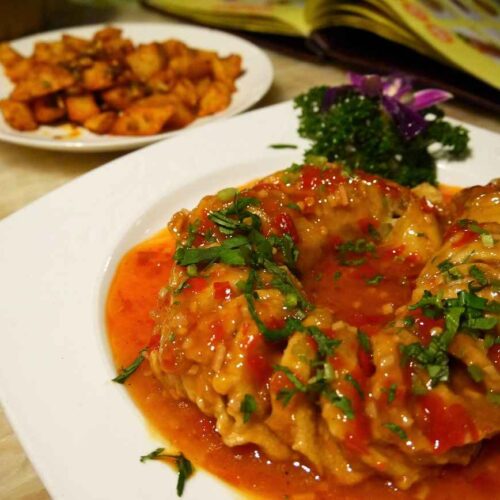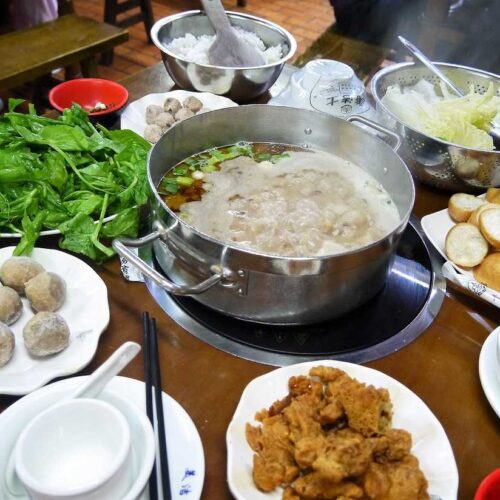Dumplings can be found all over Guiyang, and China as a whole. To find one, look for stacked steaming trays. They can be either bamboo or metal, and sit atop a steaming counter or cart. There are many kinds of dumplings with an unending variety of fillings, but today we’ll go through the three types you’ll see most around Guiyang. All of them are pork-filled.
jiǎozi 饺子
The absolute most common dumpling you can find, jiaozi, are thin-skinned crescents. They are almost always steamed, but some restaurants serve them boiled or fried. The steamed version (蒸饺 zhēngjiǎo) is dry to the touch but a bit sticky, and so is very easy to pick up with chopsticks. Boiled jiaozi (水饺 – shuǐjiǎo) are slippery buggers, and fried ones (锅贴 guōtiē or 煎饺 jiānjiǎo) are browned and crunchy. In the photo here, the jiaozi are steamed, and are served on a bamboo steamer tray. One serving is one tray, usually 8 dumplings.
xiǎolóngbāo 小笼包
Xiaolongbao are miniature stuffed bun dumplings. They are very different from the xiaolongbao that are famous in Shanghai. Instead, they are a scaled-down version of bāozi 包子, the palm-sized pork buns available in every Chinese city. Their smaller size makes them handy to share or to dip in a soy sauce, vinegar, and lajiao mix.
As with jiaozi, xiaolongbao are ordered per tray. You can ask for yī lóng xiǎolóngbāo (一笼小笼包) to get one tray.
guàntāngbāo 灌汤包
These dainty little tidbits are guàntāngbāo, soup-filled dumplings. Along with the ground pork and onion filling, there’s a tiny bit of soup inside them. They have very thin skins, like jiaozi, and come in little tart cups so that the soup doesn’t leak out if they burst. It’s really important to get these fresh. If they’ve been steaming a bit too long they dry out. They’re still good, but the soup will have disappeared. Go around meal times to get the freshest ones. As a mid-afternoon snack, these babies fall flat.
Not every dumpling place offers every kind of dumpling, so just keep an eye on what other people are eating, and what you can see when they lift the lids of the steamer trays. For reference, here’s the menu of my local dumpling joint:
鲜肉小笼包 – xiǎnròu xiǎolóngbāo – Fresh pork mini stuffed buns
灌汤小笼包 – guàntāng xiǎolóngbāo – Soup dumplings
生煎包 – shēngjiānbāo – Pan-fried xiaolongbao
白米粥 – báimǐ zhōu – White rice congee
黑米粥 – hēimǐ zhōu – Black rice congee
南瓜粥 – nánguā zhōu – Pumpkin congee
皮蛋瘦肉粥 – pídàn shòuròu zhōu – Century egg and lean pork congee
卤鸡蛋 – lǔjīdàn – Soy sauce stewed egg
咸鸭蛋 – xiányādàn – Salted, boiled duck egg
无矾油条 – wúfán yóutiáo – Deep fried dough stick
You can find dumpling places on nearly every street in Guiyang. They’re generally quite easy on new expats’ stomachs, so they’re popular with foreigners. Aside from being easy to eat, they’re cheap, tasty, and convenient. If you want to try more kinds of dumpling fillings, you’d probably be happy at Beijing Dumpling House, but for grabbing a quick meal on the way to work, run-of-the-mill dumpling joints are just right.







